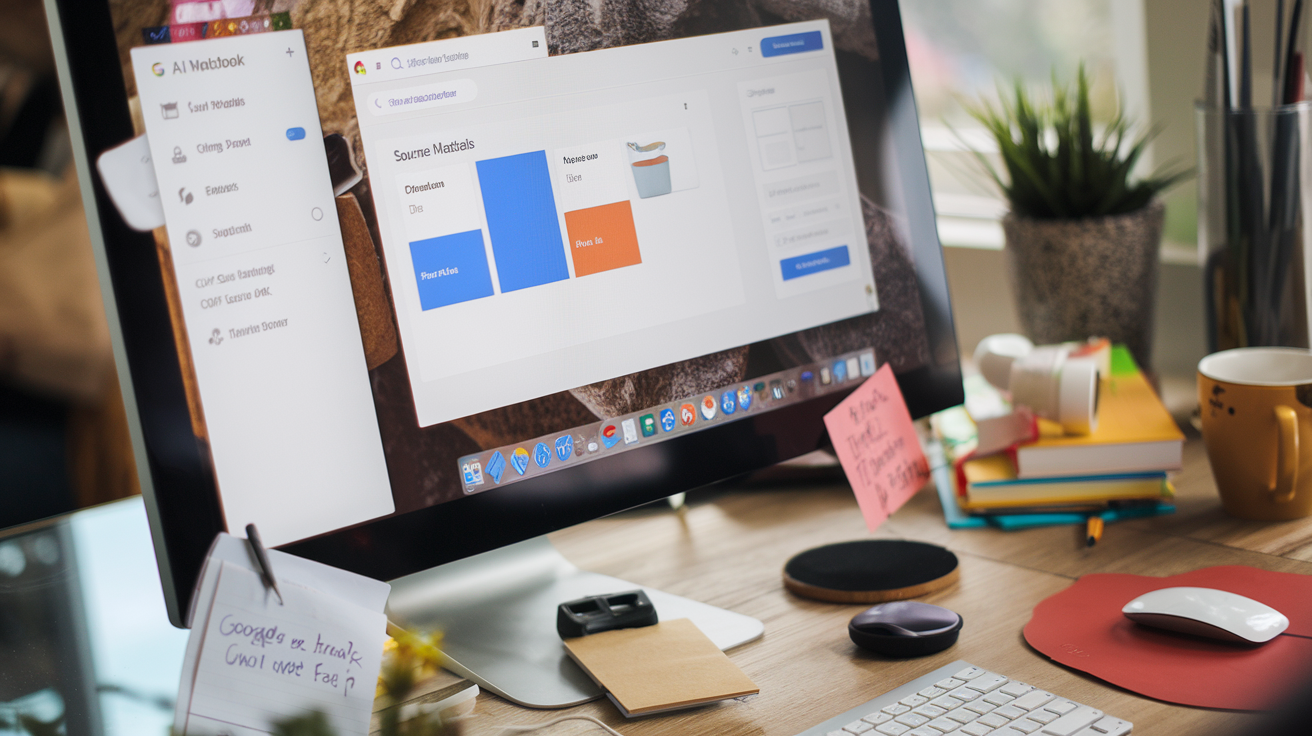Ever stared at your research notes scattered across 17 different tabs, wondering how to make sense of it all? You’re not alone. Information overload is the silent productivity killer for researchers, students, and curious minds everywhere.
Google NotebookLM might just be the AI sidekick you’ve been waiting for. It’s not just another note-taking app—it’s an AI-powered research assistant that actually understands your sources and helps you make connections you might miss.
Unlike other AI tools that generate vague responses from who-knows-where, NotebookLM grounds its insights directly in your documents. Upload research papers, transcripts, or articles, and watch as it transforms into your personal knowledge navigator.
But what happens when you ask it to explain complex concepts from your materials in simple terms? That’s where things get interesting…
Understanding Google NotebookLM: The Next Generation Research Tool

A. What is NotebookLM and how it revolutionizes note-taking
Google NotebookLM isn’t just another note-taking app—it’s a complete rethinking of how we work with information. At its core, NotebookLM is an AI-powered research assistant that helps you make sense of complex information by organizing, connecting, and extracting insights from your source materials.
The old way of researching meant endless copying and pasting, struggling to find connections between different sources, and manually organizing your thoughts. NotebookLM changes all that.
When you upload documents to NotebookLM, the system doesn’t just store them—it actually reads and understands them. This means you can have conversations with your sources, ask questions about specific content, and get summaries that pull from multiple documents at once.
What makes this revolutionary is how it transforms passive note-taking into an active, collaborative process. Instead of just collecting information, you’re engaging with it. The AI helps you discover connections you might have missed and surfaces relevant information right when you need it.
B. Key features that set NotebookLM apart from traditional note apps
Traditional note apps are basically digital versions of paper notebooks. NotebookLM is something entirely different:
Source grounding: Everything NotebookLM generates is directly tied to your source materials. No hallucinations or made-up information—just insights backed by your documents.
Contextual questioning: Ask anything about your sources and get answers that pull from the entire collection. The system understands the context across all your materials.
Smart summaries: Generate concise, accurate summaries of individual documents or your entire collection with a single click.
Note suggestions: The AI identifies key concepts and suggests notes you might want to take, helping you capture important information you might otherwise miss.
Citation tracking: Every insight comes with specific citations back to your source materials, so you always know where information came from.
Concept connections: The system automatically identifies relationships between ideas across different documents, creating a knowledge graph of your research.
The difference is night and day. Traditional apps store information. NotebookLM actually helps you think.
C. How Google’s AI powers the NotebookLM experience
Behind NotebookLM’s intuitive interface lies some serious AI muscle. The system is built on Google’s language models—the same technology powering some of their most advanced AI systems.
These models don’t just search for keywords; they understand meaning and context. When you ask a question, NotebookLM doesn’t just look for matching words—it comprehends what you’re asking and finds relevant information even if it’s phrased differently in your sources.
The magic happens through several AI capabilities working together:
Natural language understanding: The system processes your documents and queries using advanced semantic comprehension, grasping nuance and context.
Information synthesis: NotebookLM can combine information from multiple sources to create coherent, comprehensive answers.
Knowledge extraction: The AI identifies key concepts, people, places, and relationships automatically, creating a structured representation of your information.
Query interpretation: The system understands ambiguous questions and can ask for clarification when needed.
What makes this particularly powerful is that all this AI capability operates within the boundaries of your specific documents. It’s like having a research assistant who’s read all your materials deeply and can help you navigate and connect the information in ways you couldn’t do alone.
Getting Started with NotebookLM

Step-by-step setup guide for new users
Getting started with Google NotebookLM is surprisingly simple. First, head over to notebooklm.google.com and sign in with your Google account. If you’re new, you’ll see a welcome screen that walks you through the basics.
Click the “Create new notebook” button on your dashboard. You’ll need to give your notebook a name—something that reflects your research topic or project. Don’t stress about making it perfect; you can always change it later.
Next, NotebookLM will ask if you want to add sources right away. You can skip this step if you’re just exploring, but adding sources is where the real magic happens. The platform currently supports PDFs, Google Docs, and plain text files.
Once your notebook is created, you’ll land on the main workspace. Take a minute to look around—the left panel shows your sources, the center is your working area, and the right panel is where NotebookLM’s AI assistant lives.
Navigating the intuitive interface
The interface is clean and uncluttered—exactly what you need when diving into complex research. Your sources appear on the left side in a collapsible panel. Click any source to view its contents or to drag quotes directly into your notes.
The center workspace is where you’ll spend most of your time. It functions like a standard document editor with formatting options, but with AI superpowers baked in. You can type normally or use the AI to generate content based on your sources.
On the right, you’ll find the chat panel. This isn’t just any chatbot—it’s specifically trained on your sources, so it can answer questions about your material with impressive accuracy. No more endless scrolling to find that one detail you vaguely remember.
The toolbar at the top gives you quick access to important functions like adding new sources, creating notes, and adjusting settings. Hover over icons to see what they do—Google has done a great job with the tooltips.
Importing your existing documents and research
NotebookLM makes importing your research materials painless. Click the “Add sources” button in the left panel, and you’ll see options to upload files or connect to Google Drive.
For PDFs, just drag and drop them into the upload area. NotebookLM will process them, making the text searchable and analyzable by the AI. This usually takes just seconds, even for longer documents.
Google Docs can be imported directly if they’re in your Drive. Just select them from the file picker and authorize the connection. Your formatting mostly carries over, though some complex layouts might simplify.
Text files work similarly to PDFs—just upload and you’re good to go. NotebookLM also remembers where each piece of information came from, maintaining citation integrity throughout your project.
Setting up your first project notebook
With your sources imported, it’s time to structure your notebook. Start by creating sections for different aspects of your research. Click the “+” button in the workspace and select “Add section.”
Think of each section as a chapter in your research story. You might have one for background information, another for key findings, and a third for questions you’re exploring.
Try asking the AI assistant to help organize your material. Type something like “What are the main themes in my sources?” in the chat panel, and it’ll analyze your documents and suggest a logical structure.
Create notes by clicking the “+” button again and selecting “Add note.” Notes can contain your own thoughts, quotes from sources (just drag and drop text from the source panel), and AI-generated analysis.
Supercharging Your Research Process

How NotebookLM helps organize complex information
Ever tried making sense of dozens of research papers scattered across your desktop? NotebookLM transforms that chaos into clarity.
Unlike traditional note-taking apps, NotebookLM doesn’t just store your documents—it understands them. Upload your PDFs, articles, and research papers, and watch as the AI creates a smart workspace that knows what’s in each document.
The magic happens when you start asking questions. Instead of manually scanning through everything, simply ask NotebookLM something like “What are the key arguments about climate adaptation across my sources?” The AI pulls relevant information from all your documents instantly.
What makes this truly game-changing is the contextual awareness. NotebookLM remembers what you’ve already asked and builds upon previous questions, mimicking how actual research conversations flow.
Using AI-powered summaries to digest lengthy documents
Reading a 50-page academic paper no longer means blocking out your entire afternoon. NotebookLM’s summary feature condenses lengthy documents into digestible chunks without losing the important stuff.
These aren’t your typical auto-generated summaries that miss the point. The AI actually understands document structure, identifying key arguments, methodologies, and conclusions with surprising accuracy.
My favorite trick? Ask for targeted summaries. Instead of a generic overview, try: “Summarize only the methodology sections from all my quantum computing papers.” The AI delivers exactly what you need, saving hours of reading time.
For research teams drowning in literature reviews, this feature alone is worth its weight in gold.
Creating connections between ideas automatically
This is where NotebookLM truly shines. The AI doesn’t just passively store your documents—it actively identifies connections between ideas across different sources.
Upload papers from different fields, and NotebookLM might point out parallels you’d never have spotted manually. Maybe that methodology in marine biology has applications for your urban planning project?
The “Explore” feature maps relationships between concepts visually, helping you see your research landscape from a bird’s eye view. It’s like having a research assistant who’s read everything you have and connects dots you didn’t even know existed.
Managing citations and sources with ease
Citation management used to be the most tedious part of research. NotebookLM keeps track of where every piece of information comes from automatically.
Ask a question, and when NotebookLM responds, it doesn’t just give you information—it tells you exactly which document and even which page that information came from. No more hunting through documents wondering “where did I read that?”
You can export these citations in various formats, making paper writing significantly smoother. The days of scrambling to rebuild your reference list at the last minute are over.
Collaborative research possibilities
Research rarely happens in isolation. NotebookLM lets you share your notebooks with collaborators, creating a shared brain trust where everyone can benefit from the AI’s insights.
Team members can add questions, contribute documents, and build on each other’s queries. The AI keeps track of who asked what and maintains the conversation history for everyone.
For research teams spread across different locations, this creates a central hub where knowledge accumulates rather than gets siloed in individual inboxes and drives.
Advanced NotebookLM Techniques

Custom prompts for deeper AI assistance
Gone are the days of basic prompts like “summarize this.” If you want to squeeze every drop of value from NotebookLM, you need to get creative with your prompts.
Try these power moves:
“Compare the methodologies in sources A and B, highlighting contradictions and areas of agreement.”
This prompt forces NotebookLM to cross-reference your sources instead of just summarizing them individually. The AI will identify patterns you might miss when juggling multiple research papers.
“Identify gaps in my current research sources and suggest specific areas where I need additional information.”
This is like having a research assistant who tells you what you don’t know you don’t know. NotebookLM will scan your materials and spot the missing pieces in your knowledge puzzle.
“Roleplay as an expert critic in [field] and evaluate the strengths and weaknesses of the argument in source C.”
When you frame prompts this way, you get more nuanced analysis than generic summaries. The AI adopts a specific analytical lens, giving you fresh perspectives on familiar material.
Optimizing your workflow with keyboard shortcuts
The mouse is slowing you down. Seriously. While everyone else is clicking around, you could be zipping through NotebookLM like a pro with these shortcuts:
| Action | Windows/Chrome OS | Mac |
|---|---|---|
| Create new note | Ctrl + Alt + N | ⌘ + Option + N |
| Search sources | Ctrl + F | ⌘ + F |
| Switch between notes | Ctrl + Tab | ⌘ + Tab |
| Format text as heading | Ctrl + Alt + H | ⌘ + Option + H |
| Quick save | Ctrl + S | ⌘ + S |
Most people don’t know about the navigation tricks either. Press Tab twice to jump directly to the source material panel. Hit Ctrl+/ (or ⌘+/ on Mac) to bring up the complete shortcuts menu.
The real productivity boost comes from chaining these together. Try this flow: create note (Ctrl+Alt+N), paste quote from source (Ctrl+V), prompt AI for analysis (Tab to prompt field), save (Ctrl+S). No mouse needed.
Integration with other Google services
NotebookLM doesn’t exist in a vacuum. It plays nicely with the Google ecosystem in ways that can supercharge your research process.
Google Drive integration is the obvious starting point. You can import PDFs, Docs, and even spreadsheets directly as source material. But the smart move is setting up a dedicated research folder in Drive that automatically feeds into NotebookLM.
What about Google Scholar? While there’s no direct integration yet, you can set up a workflow: save papers to Google Drive from Scholar, then import them to NotebookLM in batches.
The Google Docs connection is where things get interesting. Your NotebookLM outputs can be exported directly to Docs with formatting intact. This means you can:
- Research and analyze in NotebookLM
- Export to Docs for collaborative editing
- Publish or share the finished product
For data-heavy research, try this trick: analyze data in Google Sheets, save insights as a PDF, then feed that into NotebookLM to generate explanations of trends and patterns.
Remember that your Google account permissions carry over, so NotebookLM can access any files you have permission to view—making team research projects much smoother.
Real-World Applications of NotebookLM

Academic Research and Thesis Development
Google NotebookLM transforms how researchers tackle complex academic projects. Instead of drowning in dozens of browser tabs and scattered notes, researchers can upload their source materials directly into NotebookLM and start making connections instantly.
A doctoral candidate I know used NotebookLM to organize research for her dissertation on climate policy. She uploaded 25+ academic papers and government reports, then used the AI to identify recurring themes across documents that she might have missed. The platform generated summaries that preserved nuanced arguments while highlighting key statistics—saving her weeks of manual note-taking.
The magic happens when you ask NotebookLM questions about your sources. Unlike regular Google searches, it only pulls information from your uploaded materials, giving answers grounded in your specific research context. You can ask things like “What are the contradicting viewpoints on carbon taxation in these papers?” and get organized, citation-backed responses.
Business Intelligence and Market Analysis
Companies are discovering NotebookLM isn’t just for academics. Marketing teams upload competitor reports, industry analyses, and internal data to extract actionable insights without the usual information overload.
A product manager at a tech startup recently told me she uploaded three years of customer feedback alongside market reports. NotebookLM helped her identify emerging feature requests that correlated with broader industry trends—connections that weren’t obvious when looking at each document separately.
The platform shines during quarterly planning. Upload financial reports, customer surveys, and strategy documents, then ask NotebookLM to identify potential growth opportunities or overlooked risks. The AI doesn’t just regurgitate information; it synthesizes across documents to surface insights that might otherwise require expensive consulting work.
Content Creation and Writing Projects
Writers are finding NotebookLM particularly valuable for research-heavy content projects. Journalists, bloggers, and content marketers can upload interview transcripts, background materials, and previous articles to maintain consistency while discovering fresh angles.
A freelance writer working on a series about renewable energy uploaded technical papers, interview transcripts, and news articles. NotebookLM helped him extract compelling narratives and statistics that made complex topics accessible without sacrificing accuracy. The platform even suggested connections between seemingly unrelated developments in battery technology and grid infrastructure.
Personal Knowledge Management
NotebookLM isn’t just for professional use—it’s becoming a powerful tool for personal learning and knowledge management.
People studying for professional certifications upload textbooks, practice questions, and class notes, then use NotebookLM to create customized study guides and practice tests. The platform excels at identifying knowledge gaps and generating targeted questions for review.
Others use it as a “second brain” for hobbies and personal interests. One home renovator I spoke with uploaded DIY guides, product manuals, and local building codes to create a personalized reference system for their projects. Instead of searching through dozens of bookmarked pages, they simply ask NotebookLM specific questions about their renovation challenges.

Google NotebookLM represents a revolutionary step forward in AI-assisted research, offering powerful tools to streamline the information gathering, organization, and synthesis process. From its intuitive interface and source-grounding capabilities to advanced features like custom prompts and collaborative workspaces, NotebookLM transforms how professionals and students alike approach complex research tasks.
Whether you’re analyzing academic papers, preparing business reports, or simply trying to make sense of large volumes of information, NotebookLM can be your intelligent research companion. As AI tools continue to evolve, taking the time to master platforms like NotebookLM will not only enhance your current workflow but position you at the forefront of the AI-powered knowledge revolution. Start experimenting with NotebookLM today and discover how it can elevate your research capabilities to new heights.
